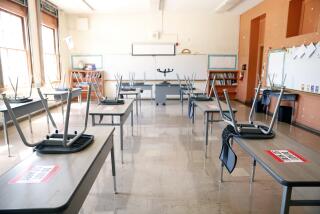What if they built a school and nobody got to go?
When it’s completed this fall, Riverside’s Hillcrest High School will be a high-tech academic hub with wireless Internet, a robotics lab, digital smart boards in every classroom and a first-rate performance hall worthy of any “Glee” hopeful.
But no students.
Sapped by state budget cuts, the Alvord Unified School District doesn’t have the money to turn on the lights or hire staff for the $105-million campus.
There’s no guarantee it will open in 2012-13, despite being built specifically to relieve the packed classrooms in the district’s other high schools.
It’s a bitter disappointment to 13-year-old Jacob Barrera, who on Thursday graduated from Arizona Middle School and had been looking forward to breaking in the new campus next year.
Since sixth grade, Jacob and the rest of what was to have been the first freshman class have been dazzled by school officials, who showed them computer mock-ups of the school and let them pick its colors and mascot: the cardinal-and-gold Trojans.
Then, last fall, the district broke the news that Hillcrest High would be mothballed for at least a year and the kids sent to La Sierra High School, a campus with 3,400 students, more than twice the number it was designed for.
“I was kind of bummed, because I really wanted to go. I’ve seen the baseball fields and, wow, they’re pretty nice,” said Jacob, a left-handed pitcher known in Little League as the “Bazooka.”
Voters in the district, which includes the Riverside communities of La Sierra and Home Gardens and a small slice of Corona, in 2007 overwhelmingly approved a $196-million bond measure to construct and equip the high school and to make other school improvements.
“The decision to build was made about five years ago, when the economy seemed to be in pretty good shape,” said Supt. Wendel Tucker. “Once the building process started, it really couldn’t stop.”
Once the recession struck, damaging the construction-dependent economy in the Inland Empire and saddling the state with billion-dollar deficits, state education funding was slashed. Tucker estimates that, in his district alone, the state cut $25 million in funding over the last three years, a hefty sum for a district with a $130-million annual budget and 20,000 students.
More than 40 full-time teachers received pink slips, class sizes were expanded, school bus routes were trimmed and extracurricular activities were cut back. Still it wasn’t enough, so the school board voted to delay opening Hillcrest High.
“It’s extremely frustrating. We made a promise to the community, and I think we need to keep it,” said board member Greg Kraft. “Still, I think people understand that it’s not because of anything the school district did. We weren’t being unwise with our money.”
Shuttering the school for a year is expected to save the district $3 million next year, not counting the $1 million it will spend to secure and maintain the empty campus.
“Hillcrest High is a perfect example of what’s wrong with state funding right now,” said Leigh Hawkinson, president of the Alvord Educators Assn., which represents teachers.
Carved in part into the golden foothills, the campus lies just south of the Riverside Freeway. On a clear winter day, students will be able to see Mt. Baldy, Mt. San Gorgonio and Mt. San Jacinto. “Hillcrest” already is spray-painted across the end zone on the artificial-turf football field, and natural grass has taken root on the soccer field and the baseball and softball diamonds.
The district joined with both the county and city of Riverside to open Hillcrest’s high-tech library to the public after school hours, as well as the campus’ swimming pool and tennis courts.
“It looks really nice,” said Natalie Mercado, 14, a recent graduate of Arizona Middle School who will be a high school freshman next year. “I really don’t want to go to La Sierra, but I guess I’ll have to go with it because I have no other choice.”
Natalie’s mother, Yolando Mercado, 36, said the new school is within walking distance of their Riverside home, which just adds to the frustration. She’s also worried about sending her daughter to La Sierra High, which is overcrowded.
“I graduated from there in ‘93, and it was old back then,” Mercado said. “It’s too bombarded with kids. How are they going to get an education when there are so many kids to focus on?”
La Sierra Principal Craig Shiflett said his school has one of the largest student bodies in the Inland Empire, requiring him to schedule early classes and two lunch shifts and to split up pep rallies and other assemblies because the gym won’t hold everyone. Class sizes for core subjects average 33 to 37 students.
Still, Shiflett said, the district has added teachers to ensure that, academically, every student is accommodated.
“Would it be nicer to have 30 to a class? Yeah, of course it would,” he said.
Kenneth M. Young, Riverside County’s superintendent of schools, said the county’s districts combined have lost more than $1 billion in state funding, leading to an increase in class sizes and the elimination of programs. Other county districts also have closed schools — some just a few years old — as have districts across the state.
“I think we’ve bottomed out as far as the economy, but here’s the thing: The state budget is still out of balance,” Young said. “That’s where the funding comes from … so that means things might not get better any time soon.”
More to Read
Sign up for Essential California
The most important California stories and recommendations in your inbox every morning.
You may occasionally receive promotional content from the Los Angeles Times.











